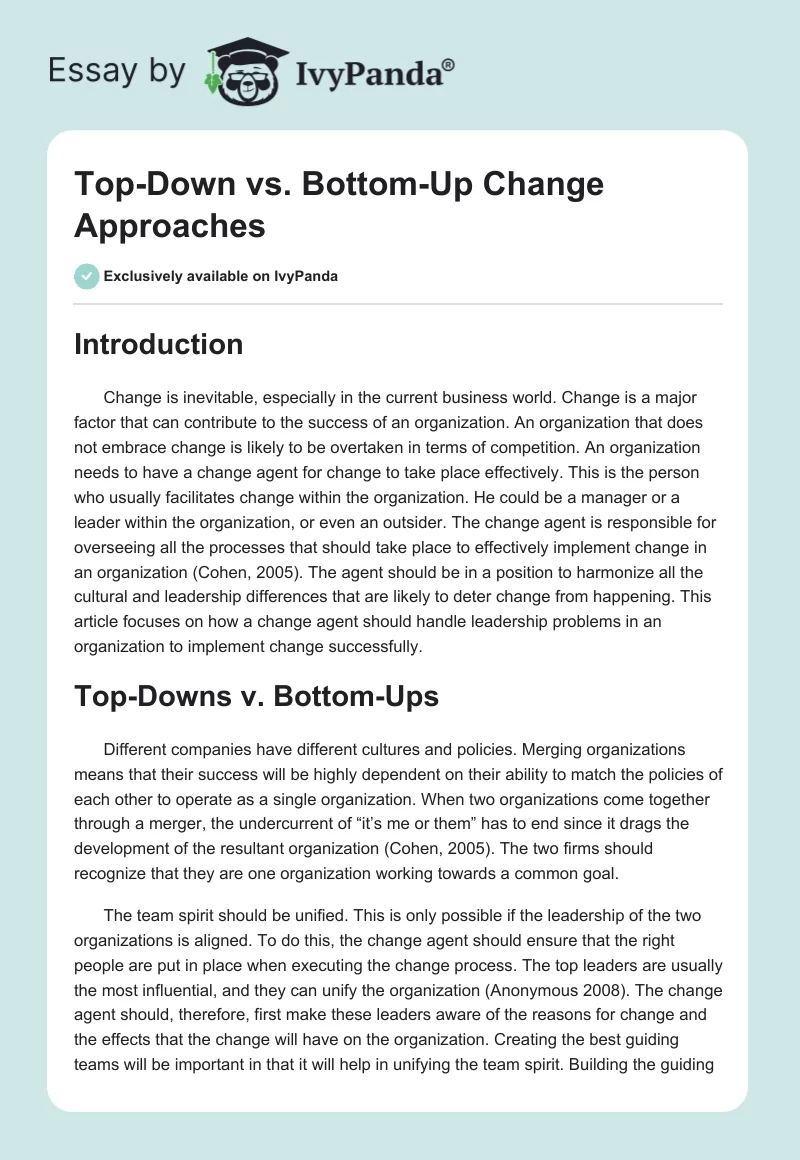Introduction
Change is inevitable, especially in the current business world. Change is a major factor that can contribute to the success of an organization. An organization that does not embrace change is likely to be overtaken in terms of competition. An organization needs to have a change agent for change to take place effectively. This is the person who usually facilitates change within the organization. He could be a manager or a leader within the organization, or even an outsider. The change agent is responsible for overseeing all the processes that should take place to effectively implement change in an organization (Cohen, 2005). The agent should be in a position to harmonize all the cultural and leadership differences that are likely to deter change from happening. This article focuses on how a change agent should handle leadership problems in an organization to implement change successfully.
Top-Downs v. Bottom-Ups
Different companies have different cultures and policies. Merging organizations means that their success will be highly dependent on their ability to match the policies of each other to operate as a single organization. When two organizations come together through a merger, the undercurrent of “it’s me or them” has to end since it drags the development of the resultant organization (Cohen, 2005). The two firms should recognize that they are one organization working towards a common goal.
The team spirit should be unified. This is only possible if the leadership of the two organizations is aligned. To do this, the change agent should ensure that the right people are put in place when executing the change process. The top leaders are usually the most influential, and they can unify the organization (Anonymous 2008). The change agent should, therefore, first make these leaders aware of the reasons for change and the effects that the change will have on the organization. Creating the best guiding teams will be important in that it will help in unifying the team spirit. Building the guiding teams is a very significant component when implementing change in any organization. The change agent should ensure that he or she gets the right people in the guiding team to increase the chances of successful change implementation (Cohen, 2005).
The guiding team should be comprised of the right people. These are people who have the right skills and leadership qualities. These are the people who can handle the intended change and have the connections to do so. People in the guiding teams should be in a position to work together in that they trust each other. These are people who can create the feeling that change is possible. Also, members of the guiding team should be experienced in managing change, they should have sufficient time to do so, and they should respect one another, as well as respect their peers. It is also important to ensure that members of the guiding team can communicate effectively. Communication is the key to success for most activities. Finally, members should have diverse viewpoints about the organizations. Initially, there should be at least three guiding teams; namely, the senior guiding team, the field guiding team, and the change team (Cohen, 2005).
“Six assumptions of the structural frame of organizations”
In the first place, it is assumed that every firm is guided by its unique goals. Moreover, every firm’s operations focus on realizing the set goals. It is these goals that determine the activities that the organization will be undertaking. It is important to note that the goals and objectives of each organization are independent of those of other organizations. Secondly, it is presumed that firms enhance their performance maximally by adopting specialization and implementing division of labor. Once employees are specialized in a given activity, they can perform it better and to perfection, thereby increasing its overall efficiency of the organization (Bolman, 2003).
Thirdly, it is presupposed that it is possible to harmonize all employees’ efforts by ensuring proper coordination of employees. Each individual has their own way of doing things. The role of sound coordination and control of employees is that it guarantees that the different efforts are meshed to realize a common goal for the firm. Fourth, it is assumed that rationality is the key to proper functioning of an organization. The fifth assumption is that different organizations operate under different circumstances; therefore, the structure of each organization should be based on its circumstances. For instance, different organizations have different objectives, different environments, different workforce, and they use different technologies. Finally, structural deficiencies are likely to arise in an organization, causing problems and performance gaps. However, these problems can be solved by analyzing the current structure to identify the deficiencies, and then restructuring to reduce or eradicate the deficiencies (Bolman, 2003).
Conclusion
When an organization is contemplating a change, it is important to have a change agent who will guide it through all the activities and procedures to be followed in implementing the change. The change agent should select a guiding team that can bring positive and effective change. It is also important to consider the six assumptions of the structural frame of organizations.
References
Anonymous. (2008). Booz & Company: Organizational DNA. Web.
Bolman, L. G. (2003). Reframing organizations: Artistry, choice, and leadership. Hoboken, NJ: John Wiley & Sons.
Cohen, D. S. (2005). The heart of change field guide: Tools and tactics for leading change in your organization. Boston, MA: Harvard Business School Press.


